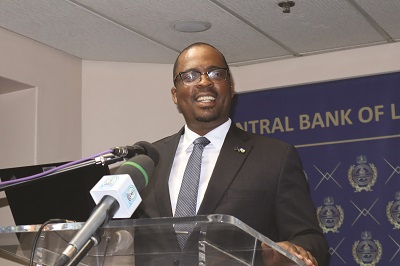By Thoboloko Ntšonyane
MASERU – In its 101 meeting on Monday, the Central Bank of Lesotho (CBL)’s Monetary Policy Committee (MPC) has again increased the CBL rate by 25 basis points.
The CBL rate is now sitting at 7.75 basis points per annum.
The Committee believes at this rate, the CBL rate will cushion consumers against the inflationary pressures.
“Having considered the NIR developments and outlook, regional inflation and interest rates outlook, domestic economic conditions, and the global economic outlook, the MPC decided to:
“Increase the CBL Rate by 25 basis points, from 7.50 per cent per annum to 7.75 per cent per annum,” said the CBL’s Governor who also doubles as MPC Chairperson.
At this rate, the consumers are expected to review and revise their spending habits. Also the commercial banks will likely increase their borrowing rate in order to accommodate these adjustments.
The MPC Chairperson further said: “The Committee noted that global economic prospects will remain weak in 2023. Global economic growth is projected to register 2.8 per cent in 2023 from the 2.9 per cent predicted in January the same year.
However, Dr Letete mentioned that it is expected to rebound to 3.0 per cent in 2024. The weak global growth mainly reflects tighter monetary policy stances across the globe, high debt levels, the continuing war in Ukraine, growing geo- economic fragmentation and recent financial sector problems.
“Economic activity in selected advanced and emerging market economies depicted mixed outcomes in the first quarter of 2023. In the US, Japan and China economic activity improved, while the Euro Area, the UK and India experienced slowdowns. The South African economy is expected to have contracted in the first quarter of 2023 owing to decreased manufacturing utilization capacity and declining mining output. The contraction is expected to continue on account of persistent energy crisis, binding infrastructure and logistics bottlenecks as well as declining commodity prices.”
Dr Letete said the domestic economic activity remained “weak” during the first quarter of 2023.
He noted that the textile and clothing manufacturing subsectors have stagnated as some factories closed shop.
The Governor highlighted that the poor performance was notable in other industries including transport and construction. .
“The near-term outlook of the economy projects an improved performance, largely on account of construction activities related to LHWP [Lesotho Highlands Water Project] Phase II.
“Inflationary pressures in the domestic economy abated in April 2023 mainly driven by falling food and fuel prices,” he said.
According to the Committee, inflation fell to 6.7 per cent in April 2023, from 6.8 per cent in the previous month. Save for the declining global food prices, domestic prices of food remained elevated due to “stubbornly” high imported inflation at the back of the weaker rand.
The Committee further indicated that money supply increased by 17.4 per cent in March 2023 following the rise by 1.7 per cent in February this year.
The rise, it said, was attributed to increases in both Net Foreign Assets (NFA) and Net Domestic Assets (NDA). This, the Chairperson said was at the back of significant increase in commercial bank’s foreign assets, following the transfers related to the Polihali project and a drawdown in government deposits held at both CBL and commercial banks.
He said the private sector credit rose due to increases in credit extended to both businesses and households.
He also highlighted that the recently introduced Alcohol and Tobacco Products Levy has moderated the inflation. This is despite this law facing strong resistance from the industry wherein they want the government to revise it.
Among their concerns is that of potential smuggling and tax evading. Meanwhile, the MPC Chairperson said they will comment deeper on the performance of this law when they have much data.
First Deputy Governor Lehlomela Mohapi said the bank is doing this to address the rate of inflation in future.
The MPC has further revised the Net International Reserves (NIR) target floor to USD 690 million, approximately M13.6 billion. At this level, the Committee believes that the NIR target will be sufficient to maintain a one-to-one exchange rate peg between Loti and the Rand.


